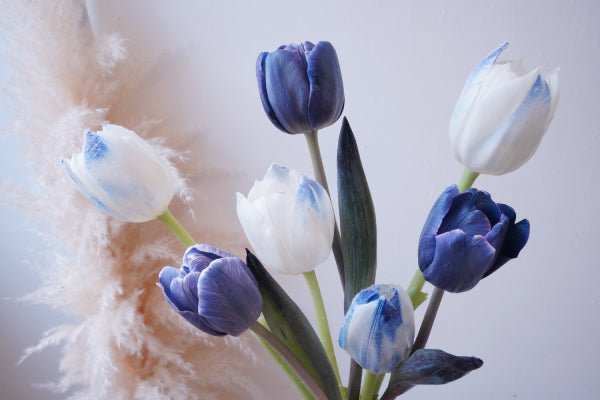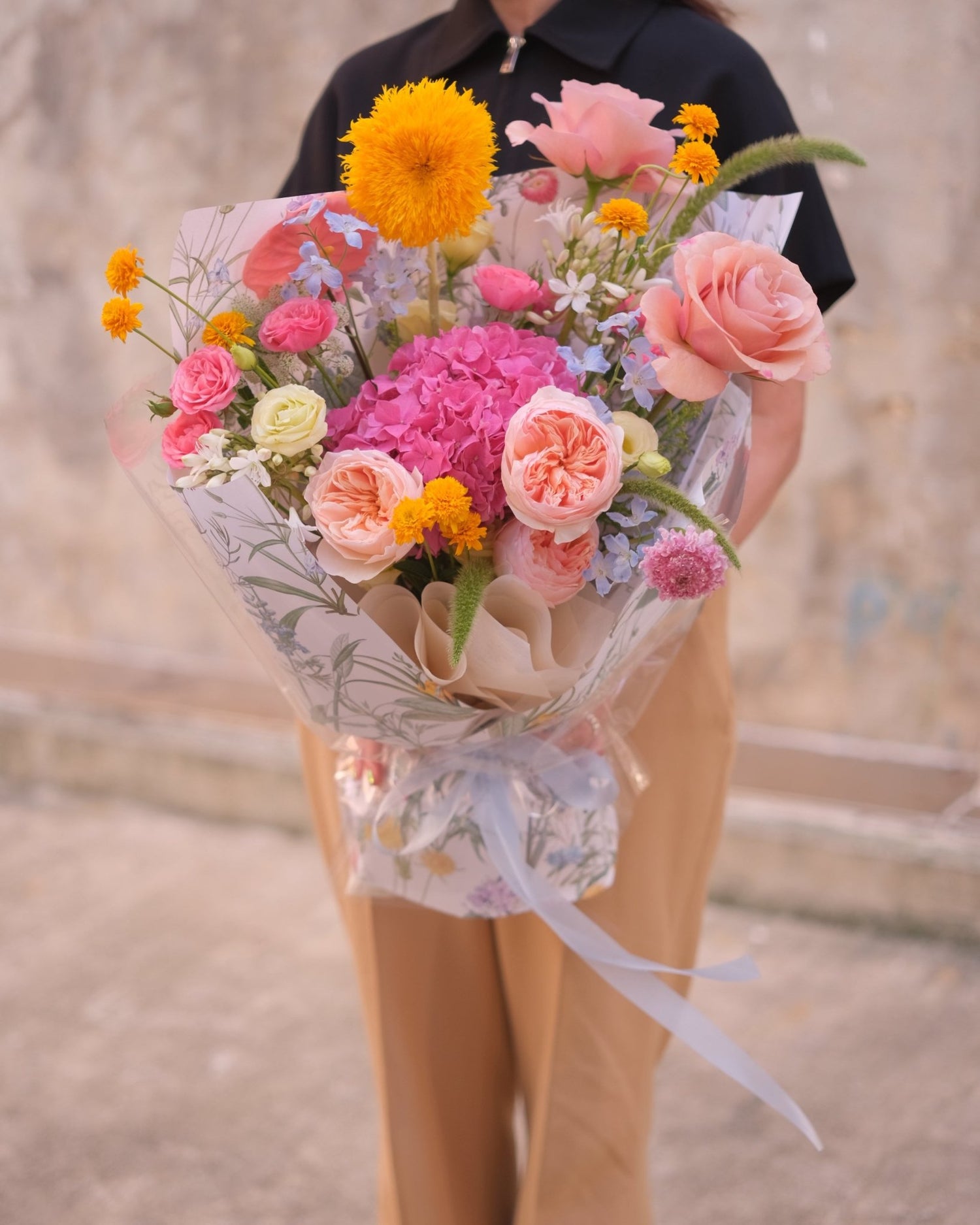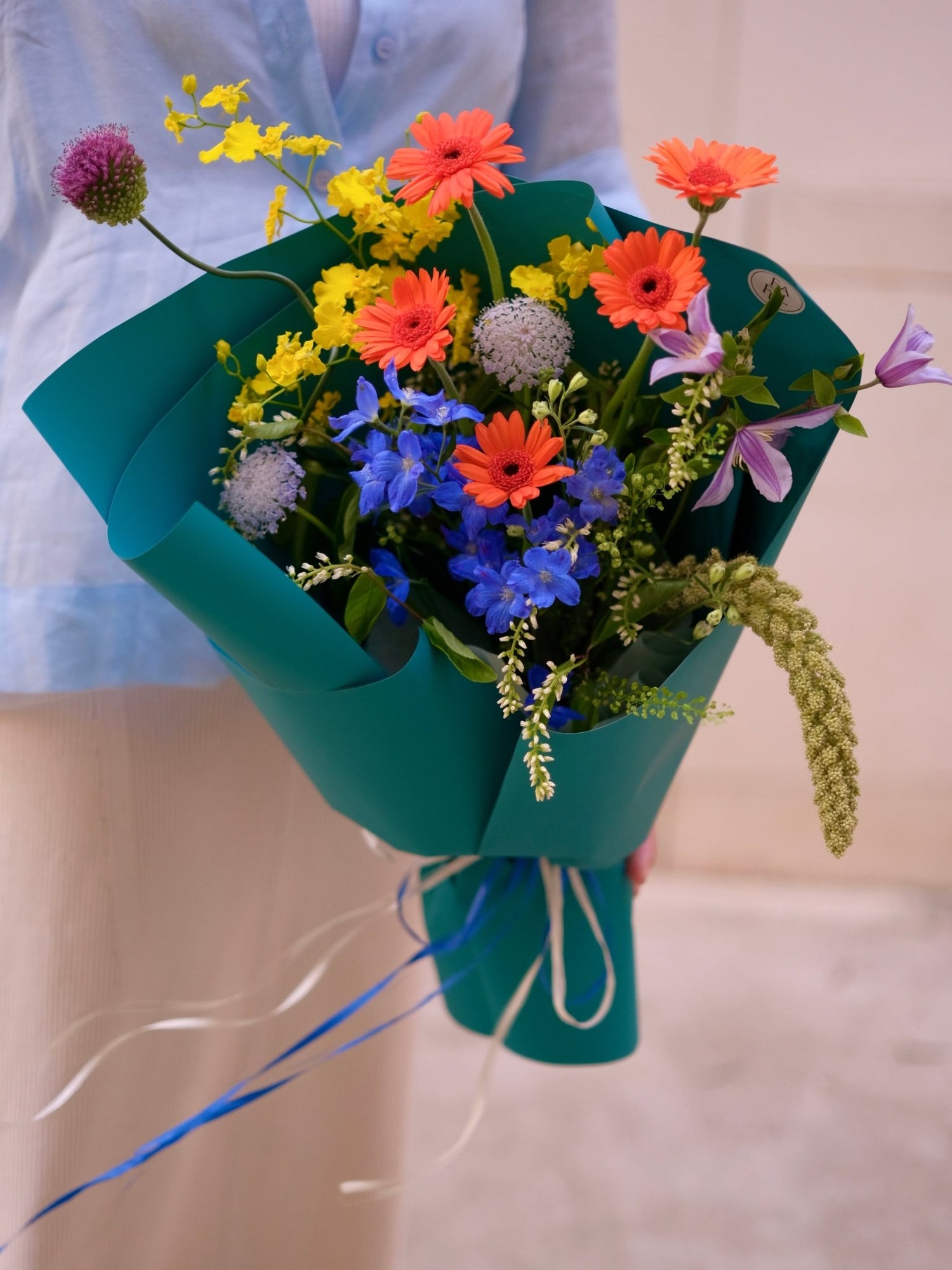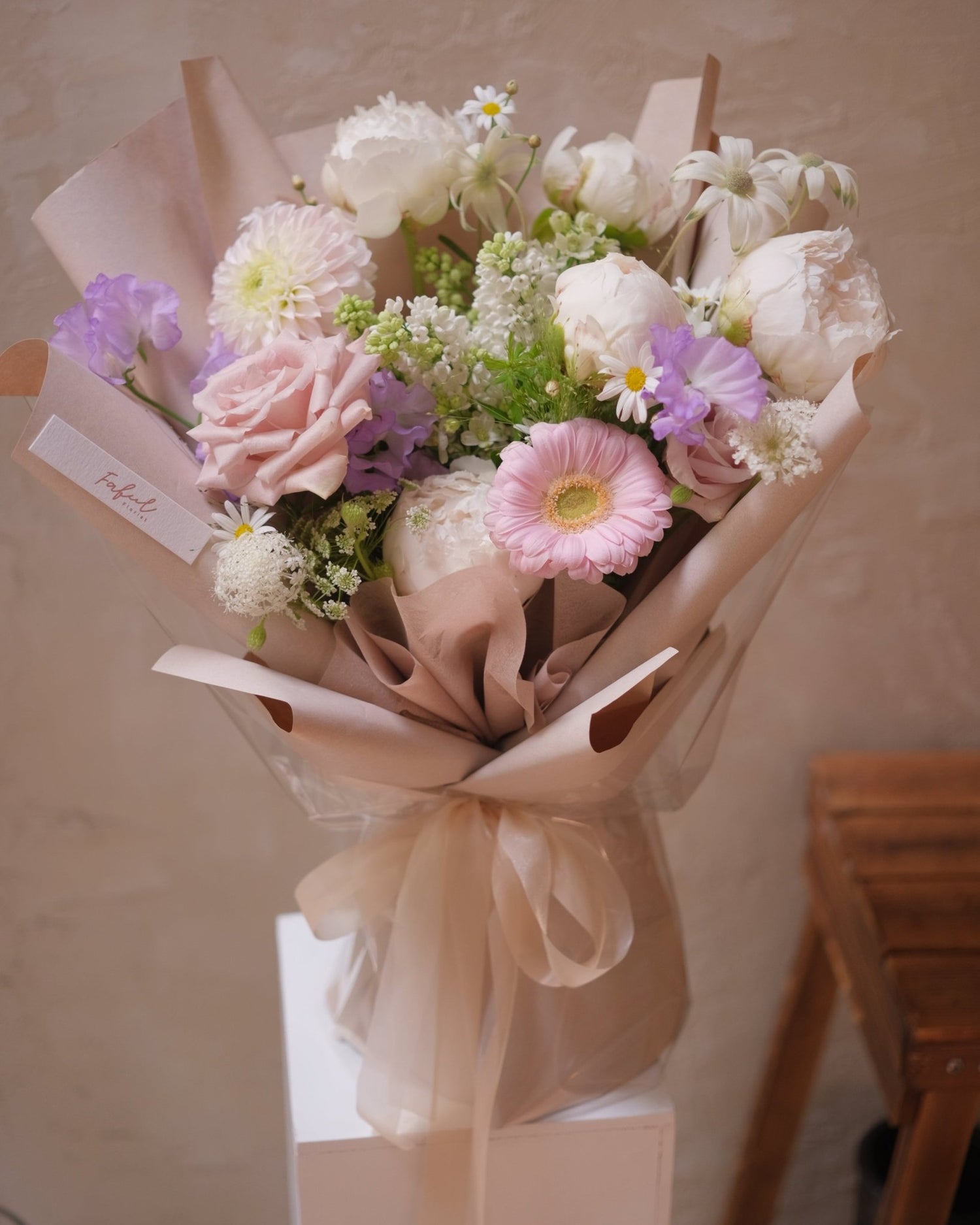Tulip Meaning: More than just a Springtime Icon
⏱️ Estimated Reading Time: 8 Minutes | 📅 Last Updated Year: 2026
Table of Contents
🌷 Tulip Flower Meaning Quick Cheat Sheet
| Color | Core Flower Meaning | Recommended Use |
|---|---|---|
| Red | Confession of Love, Passion | Romantic Confession |
| Yellow | Sunshine, Friendship, Hope | Blessing for Friends |
| Purple | Nobility, Royalty, Eternal Love | Expressing Respect |
Tulips - They are highly recognizable, adorning the earth with vibrant colors every spring, often reminding people of Dutch windmills and vast flower fields. Their elegant, cup-shaped blooms are loved worldwide. But beneath this familiar beauty lies a layer of meaning, a secret language whispered through petals. do you really understand tulips?
This article will delve deep into the fascinating world of tulip flower meanings. We will trace the tulip's extraordinary past, decode the specific flower meaning messages hidden in the rainbow of colors—from passionate red to mysterious purple—and provide guidance on how to use this knowledge to choose flowers with intention. Get ready to see the seemingly ordinary tulip with fresh eyes.

The Story of Tulips: From Ottoman Glory to Dutch Mania
The journey of the tulip through history is full of drama. Its story begins long before the Netherlands, starting in the East, intertwined with legends, empires, and an economic frenzy.
💡 The Maiden's Choice: The Legend of the Tulip's Form
In European legend, a beautiful maiden was courted by three knights with a crown, a sword, and gold. Troubled, she asked the Goddess of Flowers for help and was turned into a tulip: the flower was the crown, the leaves were like swords, and the bulb was gold, symbolizing her acceptance of all their love. Thus, the tulip became a declaration of love and a symbol of value, foreshadowing its later status.
True Origins: From Asian Mountains to Ottoman Gardens
Tulips did not originate in the Netherlands, but in the Tien Shan mountain range of Central Asia. Wild tulips flourished there and were later cultivated by Persians and Turks. By the 10th or 11th century, tulips were already being grown in Persia and Anatolia.
Ottoman Embrace: A Symbol of Paradise and Power
The tulip reached a cultural peak in the Ottoman Empire. Sultans were fascinated by them, cultivating them extensively from the 16th century onwards, making them a symbol of imperial power. The tulip (Lale), due to its phonetic and numerical value similarity to "Allah", was given sacred status, regarded as a symbol of paradise, wealth, and power, and also represented humility. This reverence was reflected in clothing, tiles, artworks, and poetry. The famous "Tulip Era" (early 18th century) was a period of extreme cultural attention to this flower, its opulent scenes symbolizing the empire's glory.

Arrival in Europe & Dutch Golden Age
Tulips were introduced to Western Europe in the second half of the 16th century; their European name "tulip" likely originated from a misunderstanding of the Turkish word for "turban" (tülbent). Botanist Clusius brought them to the Leiden University Botanical Garden in the Netherlands in 1593, where the Dutch climate proved extremely suitable for their growth. Clusius also recorded "broken" tulips caused by viruses, whose unique patterns were highly sought after.
💡 Tulip Mania (Tulpenmanie): Beauty Becomes Madness
During the Dutch Golden Age, tulips rapidly became a status symbol due to their novelty, exotic origin, and rare broken-color varieties. Between approximately 1634 and 1637, this evolved into a speculative frenzy known as "Tulip Mania"—one of the earliest speculative bubbles in history. Tulip Mania was a speculative trend in the early 17th century where bulb prices soared, and the bursting of the bubble affected related speculators. This event became a historical lesson on collective mania leading to asset prices far exceeding value, and although the economic impact was limited, it sparked cultural reflection and satire.
Tulips Today: A Symbol of the Netherlands and a Global Favorite
Despite the mania, tulips eventually became the national flower and cultural icon of the Netherlands, which is the world's largest producer and exporter of tulips; Turkey mainly uses tulips as a cultural symbol and for ornamental purposes; China is an emerging market for cultivation and consumption, mainly relying on imported bulbs.

Decoding the Rainbow of Tulip Flower Meanings: A Spectrum of Significance
Beyond its dramatic history, the tulip expresses a rich language through its diverse colors. Although this flower generally symbolizes concepts such as love (often described as "perfect love" or "declaration of love"), beauty, elegance, fame, charity, wealth, and eternal blessings, each shade offers more specific nuances, allowing for the delivery of tailored messages. These meanings often echo themes from the maiden legend—love, value, and beauty.
Red Tulip Flower Meaning: Undeniable Declaration of Love
The red tulip is universally recognized as a bold and passionate expression. Just like the Red Rose, it symbolizes deep love, intense passion, desire, and romance. Its primary message is often interpreted as a direct "confession of love" or "declaration of love," conveying sentiments of "I love you" or "Believe me." The fiery hue embodies warmth, intense emotion, and commitment.
Occasion: Red tulips are the quintessential choice for a romantic partner, perfect for Valentine's Day, anniversaries, proposals, or any moment meant to express deep love and affection. They can also convey joy and sincere warmth.
Yellow Tulip Flower Meaning: Sunshine and Shadows
The yellow tulip presents a fascinating duality in its symbolism.
Positive Meaning: Today, yellow tulips are primarily associated with sunshine, happiness, cheerfulness, and hope. They are closely linked to friendship, positive thoughts, and transmitting warmth. Some traditions also link them to wealth, prosperity, elegance, victory, and fame. The message can be as simple and bright as "There's sunshine in your smile."
Negative Meaning: However, a persistent (though perhaps less common today) interpretation links yellow tulips to negative emotions. This includes hopeless or unrequited love, jealousy, and rejection. This view mainly comes from certain Asian cultures or popular interpretations, not mainstream Western flower meanings.
Occasion: Given their predominantly cheerful associations, yellow tulips are an excellent gift for friends (to celebrate friendship, express joy or gratitude), colleagues, and family. They are suitable for celebrating achievements, wishing good luck, or simply brightening someone's day. However, due to lingering negative connotations, caution is advised when gifting in purely romantic contexts, as the message could be misinterpreted. The stark contrast between bright friendship and hopeless love highlights how flower meanings evolve and change, requiring careful consideration of context and relationship. This is also an example of the complexity of tulip flower meaning.
White Tulip Flower Meaning: Purity and Parting
Similar to yellow, the white tulip also carries dual symbolism.
Positive Meaning: Primarily, white tulips represent purity, innocence, and pure love. They symbolize sincerity, respect, honor, and new beginnings. They can also be used to express apologies or ask for forgiveness.
Negative Meaning: Conversely, white tulips can symbolize lost or ended love, mourning, or parting. This association aligns with the practice of using white flowers at funerals or memorial services in certain cultures.
Occasion: Their connection to purity makes white tulips suitable for weddings, baptisms, and celebrating new beginnings. They are appropriate for expressing sincere apologies or conveying respect. While sometimes used for condolences, the potential "lost love" meaning requires careful consideration of the specific context and relationship to avoid conveying unintended messages. The duality of the white tulip again emphasizes that the intended meaning depends largely on the situation understood by both the sender and receiver. Understanding this nuance of tulip flower meaning is important.
Purple Tulip Flower Meaning: Royalty, Respect, and Romance
Purple has long been associated with royalty, and the purple tulip strongly carries this meaning.
Meaning: They symbolize royalty, nobility, luxury, elegance, and grandeur. Beyond status, they convey admiration, respect, and dignity. In the realm of love, purple tulips represent deep, loyal, endless, or eternal love, often with a hint of mystery or fascination.
Occasion: Purple tulips are an excellent choice to express admiration or respect to mentors, teachers, elders, or people celebrating significant achievements like promotions. They can symbolize deep and enduring romantic love or add a touch of sophistication and elegance to formal events or bouquets. The purple tulip flower meaning conveys noble sentiments.
Pink Tulip Flower Meaning: Affection, Happiness, and New Romance
Softer and gentler than red, pink tulips convey warmth, affection, and happiness.
Meaning: They represent care, good wishes, happiness, confidence, and beauty (sometimes specifically implying the recipient is a "beautiful person"). In terms of romance, they symbolize gentle love, the beginning of love ("budding love"), eternal love, and romance. They embody a youthful and tender emotion.
Occasion: Pink tulips are versatile, suitable for friends, family (they are a lovely choice for Mother's Day, symbolizing gentle love and care), and budding relationships. They are perfect for birthdays, graduation, get well soon messages, or simply to express affection and transmit positive vibes. The pink tulip flower meaning is full of warmth.

Orange Tulip Flower Meaning: Energy, Passion, and Warmth
Full of vitality and warmth, orange tulips radiate energy and positivity.
Meaning: They symbolize energy, enthusiasm, vitality, warmth, happiness, and passion. They can also represent understanding, appreciation, gratitude, kindness, and thoughtfulness. Orange tulips may symbolize a strong connection or bond between people, representing shared warmth and mutual understanding, or precious memories and lasting relationships.
Occasion: These tulips are perfect for encouraging someone, expressing thanks or appreciation to friends or colleagues, celebrating success, or wishing someone well. They can symbolize the warmth and comfort of a stable relationship (whether platonic or romantic). The orange tulip flower meaning brings vitality.

Beyond the Basics: Rare Shades and Patterns
Tulip flower meaning extends beyond the most common solid colors:
- Variegated/Mixed Color Tulip Flower Meaning: Tulips with multiple colors or striped patterns often carry specific meanings. A common interpretation is "beautiful eyes," perhaps alluding to their captivating appearance. They can also signify "happy meeting" or simply "beautiful you." Mixed color bouquets can represent complex or multiple emotions simultaneously. Specific combinations may have unique meanings, such as red and yellow implying happiness and good luck, while pink and white suggest friendship and harmony. Historically, the most prized variegated tulips were the "broken" varieties caused by viruses during Tulip Mania, admired for their unpredictable beauty. Variegated tulip flower meaning is often associated with beauty and encounters.
- "Black" Tulip Flower Meaning: While not truly black (usually very deep purple or maroon), deep purple varieties (like Queen of Night) are practically close to black. These tulips exude an air of mystery and sophistication. They typically symbolize power, strength, elegance, royalty, and uniqueness. Some interpretations include chivalry, honor, or even melancholy or tragic love. Their perceived rarity enhances their mystique and value. A few sources associate them with sadness or the end of love. The black tulip flower meaning is full of mystery.

- Blue Tulip Flower Meaning: Representing the unattainable or extraordinary, blue tulips symbolize uniqueness, mystery, tranquility, peace, trust, and loyalty. They can indicate an unpredictable future or a deep, perhaps mysterious love. It is important to note that blue tulips do not exist in nature; they are usually created through dyeing or genetic modification, further emphasizing their symbolism of rarity and the extraordinary. The blue tulip flower meaning points to uniqueness and tranquility.
- Green Tulip Flower Meaning: Usually having green flames or stripes on the petals (Viridiflora group), describing varieties with green markings on petals, not naturally occurring pure green. Green tulips symbolize renewal, rebirth, hope, new beginnings, good luck, and health. They are directly linked to nature and vitality.
- Gold Tulip Flower Meaning: Unlike yellow, gold tulips carry a more grandiose and celebratory meaning. They symbolize congratulations, prosperity, achievement, and good luck, making them suitable for marking important milestones or sending best wishes. Describes varieties with golden yellow on petals, not naturally occurring pure gold.
The symbolism attributed to these rarer or artificially achieved colors—black, blue, green—seems often directly linked to their perceived uniqueness or unnaturalness. Their scarcity or deviation from the norm amplifies meanings such as mystery, the unattainable, specialness, or renewal, suggesting that human perception of rarity itself shapes the symbolic value assigned to them.

Choosing Your Message: Gifting Tulips with Intention
Understanding tulip flower meanings transforms the simple act of giving flowers into a thoughtful and personalized message. By choosing colors with intention, a bouquet becomes a silent yet eloquent expression of emotion.
Matching Color to Occasion and Recipient
Based on the decoded meanings of tulip flower meanings, here are some suggestions for choosing the right tulip color:
-
Romantic Love
- Passion/Deep Love: Red is the classic choice.
- Gentleness/New Romance: Pink conveys affection and budding romance.
- Eternal/Loyal Love: Purple symbolizes depth and lasting commitment.
- Stable Warmth/Comfort: Orange is suitable for long-term relationships.
- Pure Intentions/Apology: White can express sincerity, use with caution due to potential negative connotations. Be mindful of potential negative tulip flower meanings of yellow and white in romantic contexts.
-
Friendship:
- Joy/Gratitude: Yellow is perfect for brightening a friend's day or showing thanks.
- Care/Best Wishes: Pink expresses affection and support.
- Warmth/Appreciation: Orange conveys enthusiasm and gratitude for the connection.
- Pure Friendship: White can symbolize the sincerity of a platonic bond.
-
Respect and Admiration:
- Nobility/High Regard: Purple is perfect for mentors, elders, or respected figures.
- Honor/Sincerity: White conveys respect and pure intentions.
-
Celebration (Birthday, Graduation, Promotion):
- Happiness/New Beginnings: Pink is suitable for celebratory occasions.
- Joy/Success: Yellow brings joy and congratulates achievements.
- Enthusiasm/Congratulations: Orange expresses excitement for their success.
- Grand Congratulations: Gold marks significant achievements.
-
Get Well Wishes and Encouragement:
- Cheerfulness: Yellow brings a sunny disposition.
- Vitality/Warmth: Orange provides a boost of energy and care.
- Care/Affection: Pink sends gentle blessings.
-
Apology or Condolence:
- Sincerity/Forgiveness: White can indicate apologies and pure intentions. However, use white with caution for condolences due to its tulip flower meaning of "lost love"; context is crucial.
- Warmth/Comfort: Red tulips can also offer comfort and warmth during difficult times.
Considering Nuances
When choosing tulips, always keep in mind the potential dual meanings, especially for yellow and white varieties. Consider your specific relationship with the recipient and the context of the gift giving. Cultural background and personal associations also influence the perception of flower colors. Taking these factors into account ensures your floral message is received as intended.

Conclusion: The Enduring Language of Tulips
The story of the tulip is a journey of remarkable transformation. From its humble origins in the mountains of Central Asia, it spread west to become a revered symbol in the powerful Ottoman Empire, synonymous with paradise and power. Its arrival in Europe sparked horticultural enthusiasm, famously escalating into the speculative frenzy of Dutch Tulip Mania, before settling into its role as a beloved global flower and an enduring symbol of the Netherlands.
Throughout this incredible history, the tulip has accumulated a rich and complex symbolic language. As we have seen, its various colors hold deep meaning, capable of conveying the entire spectrum of human emotion—from the fiery declaration of passionate love in red, to the cheerful sunshine of friendship in yellow, the noble respect of purple, and the gentle affection of pink. Blending history, legend, and evolving cultural perceptions, the tulip flower meaning embedded in each hue offers a fascinating perspective on how we communicate our deepest feelings through flowers.
Even in our modern world, understanding these hidden tulip flower meanings adds a profound layer of appreciation to the tulip's simple beauty. It allows us to choose and gift these flowers more consciously, transforming a beautiful bloom into a meaningful connection across time, echoing the emotions expressed by humanity through the silent yet eloquent language of flowers for centuries. Next time spring arrives and tulips unfold their vibrant petals, perhaps take a moment to look more closely, listen more quietly, and appreciate the stories they are still telling.

Quick Guide to Tulip Flower Meanings by Color
For easy reference, here is a summary of tulip color meanings and suitable occasions:
| Color | Primary Positive Meaning | Potential Negative/Nuanced Meaning | Suitable Occasion/Recipient |
|---|---|---|---|
| Red | Deep love, Passion, Confession of love, Romance, Joy | - | Romantic partner (Valentine's Day, Anniversary, Proposal), Expressing deep emotion |
| Yellow | Friendship, Cheerfulness, Happiness, Hope, Wealth, Success | Hopeless love, Jealousy, Rejection | Friends, Colleagues, Family; Celebrating achievements, Get well wishes, Cheering someone up |
| White | Purity, Innocence, Pure love, Respect, New beginnings, Apology | Lost love, Mourning | Weddings, Baptisms, Apologies, Expressing respect; Use with caution for condolences |
| Purple | Royalty, Nobility, Elegance, Admiration, Respect, Deep/Eternal love | Mystery | Expressing admiration/respect (Mentors, Elders), Promotion, Deep love, Formal occasions |
| Pink | Affection, Care, Happiness, Good wishes, Gentle/New/Eternal love | - | Friends, Family (Mother's Day), New relationships, Birthday, Graduation, Get well wishes |
| Orange | Vitality, Passion, Warmth, Happiness, Appreciation, Gratitude | Desire | Encouragement, Expressing thanks (Friends, Colleagues), Celebrating success, Warm relationships |
| Variegated | Beautiful eyes, Happy meeting, Complex emotions | Virus-induced (Historically) | Adding visual interest, Expressing admiration, Celebrating an encounter |
| Black | Mystery, Power, Elegance, Uniqueness, Royalty | Melancholy love, Sadness | Making a unique statement, Expressing deep admiration or fascination |










